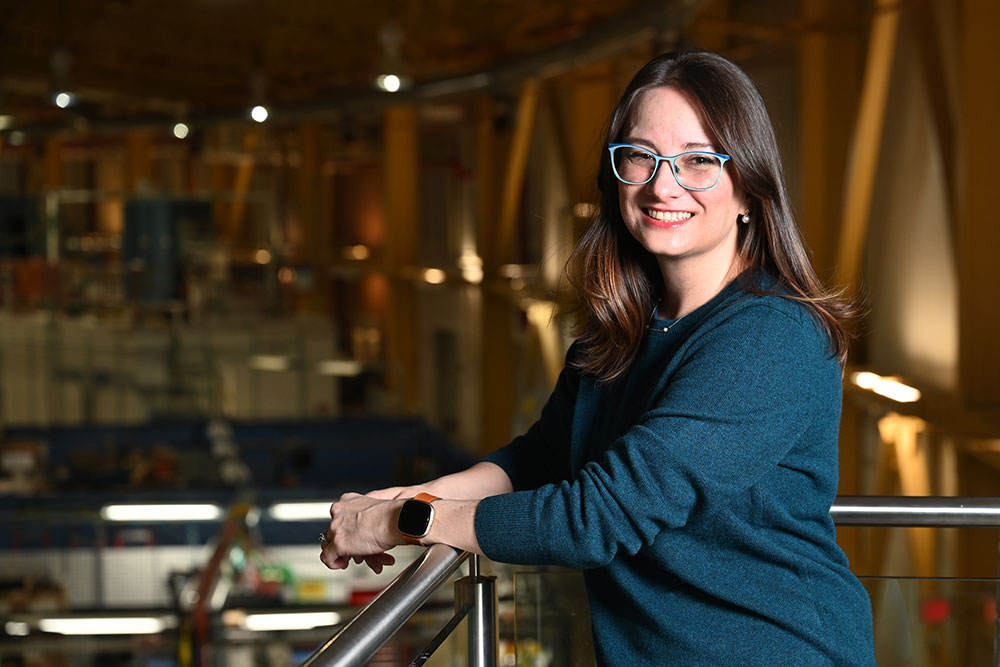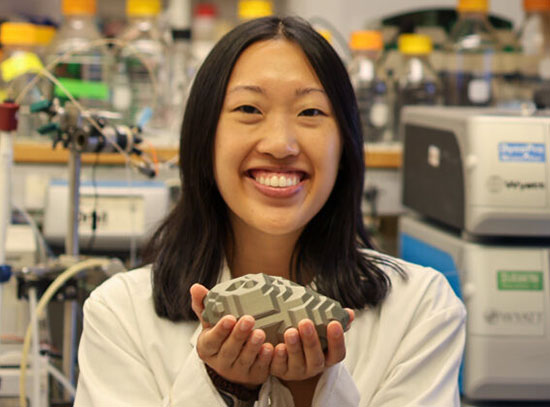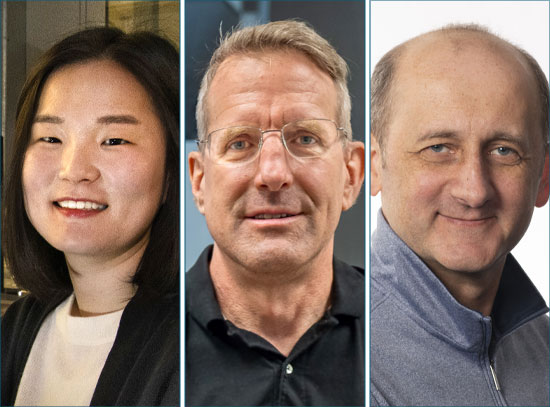Lacy Jones Engineers the Framework that Supports Great Science at NSLS-II
June 25, 2025
Lacy Jones, an operations engineer at the National Synchrotron Light Source II (NSLS-II), plays a key role in making high-impact science possible. By implementing new programs and procedures, she helps improve the efficiency and productivity of one of the world’s most advanced X-ray light sources. NSLS-II, located at the U.S. Department of Energy’s (DOE) Brookhaven National Laboratory, is a DOE Office of Science user facility. The intense beams of X-ray light it produces enable cutting-edge research into a wide variety of materials and biological samples. Behind every cutting-edge discovery at NSLS-II is a team of dedicated professionals like Jones, working to ensure the facility runs at its best.
What is your background?
My life in science started when I fell in love with chemistry as an undergrad. My first job in the national laboratory system was as a DOE Science Undergraduate Laboratory Internships (SULI) participant at Pacific Northwest National Laboratory. That experience inspired me to pursue a scientific research career at the national laboratories. Prior to starting at NSLS-II, I had previous roles in technical project management and day-to-day operations support on beamlines at two other DOE user facilities located at Oak Ridge National Laboratory — the Spallation Neutron Source and High Flux Isotope Reactor. It was a lot of fun. I started my career with a master’s degree in environmental geochemistry and a specialty in spectroscopy. I was able to leverage this degree for a position as a geochemist at a hydrology consulting company before switching gears and harnessing that spectroscopy specialty when I started working at the neutron scattering user facilities at Oak Ridge. While there, I was able to expand my career opportunities with a second master’s degree in industrial engineering, which was somewhat of an engineering management specialty. This new degree and accumulative experience led me to this role at NSLS-II, which I have held now for about three and a half years. I’m also grateful and need to give credit to the excellent mentoring I have had throughout my career, both formal and informal. My dream after my internship was to be hired full-time at a DOE national laboratory, as I love the research environments provided by these labs. They specialize in creating optimal atmospheres to ignite science and technology innovation and of which I am so proud to be a part.
Your work is multi-faceted. Can you boil it down for us?
I’m in science support. My current job is to build new processes, or to improve the existing ones, that underlie operations at NSLS-II. I bridge the gap between regulatory requirements and scientific staff implementation; I also identify opportunities for efficiency and then work out how to address them by engaging stakeholders as part of our overall strategy to enable a world-class research experience for our staff and users.
My responsibilities can vary, but one important example would include helping staff navigate research security requirements, including reviewing research and development activities and determining what work is open science and what is not. That’s an “official” way to say, for instance, that I might screen a presentation before it is shared at a conference, review a technical design drawing before it is sent to a vendor, or create a guidance document that teaches others how to screen the information quickly in order to maintain compliance with DOE directives and U.S. regulations during operations. I’m either carrying out the steps of a process myself or creating a system that guides others through it efficiently.
I get to work with many different stakeholders — all the people who are involved in implementing requirements or those who will be impacted by them. These stakeholders are both within NSLS-II and at Brookhaven: management, scientists, engineers, technical experts, operations professionals, and regulatory compliance agents. In addition, I sometimes communicate with our NSLS-II users from around the world or with operations specialists at other DOE national laboratories for benchmarking and collaboration. Oftentimes, it feels like these different groups are speaking different languages because of their distinct focuses. For instance, from my perspective, engineers are more analytical, scientists are more research- and user-focused, and compliance specialists are more specific to the terms of their respective fields. So, operations roles like mine get to be a hub for communication, liaisons connecting these different groups to form a coordinated team to get things done and achieve something bigger than ourselves. This is what I call a “people system” from a systems-thinking approach. Sometimes this alignment is as simple as making sure everyone is on the same page, and other times it involves engineering a new solution. Working together, we make operations tasks more efficient to achieve our science mission in a safe and secure environment.
What are some additional tasks that you regularly have to undertake?
What I have going on day-to-day largely depends on which operational workflows we are reviewing or where we are in an implementation. The first step is to understand the requirements, and the next step is to analyze the workflows — inputs and outputs — and interconnectivities between groups that would be most impacted by any change or have the greatest impact on the overall goal. I collaborate with others to set up these workflows and “people systems,” as well as to develop training, management reporting tools, key performance indicators assessments, etc. Each implementation is an iterative approach with pilot programs, benchmarking, assessments, and seeking feedback from the various groups.
What do you find rewarding about your job?
I enjoy learning and understanding how things work, and I find lots of opportunities for that in my job. Analyzing systems and improving processes is like a very fun puzzle for me to solve. How is something being done now? How can it be done better? How can we remove unnecessary obstacles to make things easier for everyone involved?
This is my passion and the best part of my job — making work easier and more efficient for people. I also love that, along the way, I am supporting something that is greater and more far-reaching. I get to be a part of fostering world-class research and creating cutting-edge technologies.
I enjoy that I get to work across many groups with people from around the world, sharing knowledge and lessons learned. I love hearing about these varied experiences and having those distinct ideas to inspire me. Solving the problems of tomorrow requires pulling from these multidisciplinary collaborations.
What are some of the challenges you face in your role?
Any time change is involved, it can be difficult. I try to manage this by considering the existing infrastructure. You can’t “fix” something without first understanding its current state. I like to give credit for existing work where I can and make workflows easier when I can. The most sustainable change includes stakeholder buy-in and ownership. Of course, as with many jobs, there is never just one process implementation happening at once; thus, sometimes the challenge is the sheer number of details I must keep track of. I have a million tabs open both on my computer and in my head.
Also, operations can be all-encompassing, and I try to stay flexible to the priorities and mission of the institution. Because my job can change so much, I sometimes have to learn a brand-new specialty, perform the day-to-day tasks that this new specialty requires, and be able to teach others — sometimes all at the same time. I have to be able to speak with compliance specialists and management to understand the big picture, while also studying the details enough to communicate with technical experts who better understand how this impacts the day-to-day operations and science. I have to become an expert on the new requirements, set up the most efficient process, engage with others so that they can take ownership of it, and then move on. There is always another project to move onto, because as we continue to grow as a facility, operations processes will continue to be standardized and optimized as we take on more work and provide solutions for increasingly complex research experiments.
What are a few of your hobbies and interests outside of work?
I’m a bit of a foodie and an avid coffee drinker, and I really enjoy going to independent coffee shops. I grew up in the mountainous region of Washington state, so I like outdoor activities, such as hiking, cross-country skiing, and water sports, but visiting coffee shops is one of my favorite activities still, and I found that to be part of the culture there. Independent coffee shops were everywhere, probably still are, and I am passionate about supporting small and local businesses. But I have also come to appreciate the standardization and availability of Starbucks, another business local to Washington state. Plus, they have incredible, pioneering operations management strategies and process workflows!
Here on Long Island, I like going to the beach and concerts. Taking the train into the city is so convenient and easy. Having multiple airports and available modes of transportation is also convenient as I like to travel with my family, but mainly my life outside work revolves around my children’s activities. There is always fun to be found with that; for instance, tennis is my new favorite activity and sport that my kids just took up. Lastly, I also love a good jigsaw puzzle and murder mystery novel to solve! Agatha Christie is my favorite author. To me, she was a mastermind, partly because of the way she seemed to understand complex human interactions and how they played into causing, and provide all the clues to solving, the mystery.
Brookhaven National Laboratory is supported by the Office of Science of the U.S. Department of Energy. The Office of Science is the single largest supporter of basic research in the physical sciences in the United States and is working to address some of the most pressing challenges of our time. For more information, visit science.energy.gov.
Follow @BrookhavenLab on social media. Find us on Instagram, LinkedIn, X, and Facebook.
2025-22502 | INT/EXT | Newsroom










